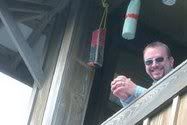the story of kudzu
all you faithful readers of this page may remember the question i asked you last week. well, you're fixin' to learn some good stuff.
remember i asked you what kudzu was and what was done to try and get rid of it? well, the follwing is from the following web site, http://www.jjanthony.com/kudzu/.
when i was asking what was done to get rid of the parasitic vine i had a friend tell me while i was living in texas that the rodent nutria was brought in to help aleviate the kudzu epidemic. well ... as legend has it ... it was an urban legend. can you tell me how the nutria actually started their breeding ways in the u.s.? that's you assignment. where did the nutria come from, and why are they all over the southeast?
Kudzu is native to Japan and China, however it grows well in the Southeastern United States. Kudzu is a vine that when left uncontrolled will eventually grow over almost any fixed object in its proximity including other vegetation. Kudzu, over a period of several years will kill trees by blocking the sunlight. For this and other reasons many would like to find ways to get rid of it. The flowers which bloom in late summer have a very pleasant fragrance and the shapes and forms created by kudzu vines growing over trees and bushes can be pleasing to the eye.
The following statement appeared in an agricultural bulletin in 1928, about 20 years after it was first introduced in Florida as a forage crop. "Kudzu is not without disadvantages. It is slow and expensive in getting established, is exacting in requiring only moderate grazing and mowing, is deceptive about its real yield, especially to those who do not know it well, and sometimes becomes a pest."
In the south where the winters are moderate the first frost will turn kudzu into dead leaves and soon after just gray vines. The kudzu vine will continue growing the next summer almost from where it was stopped by cold weather the previous year. These vines will cover buildings and parked vehicles over a period of years if no attempt is made to control its growth. A number of abandoned houses, vehicles and barns covered with kudzu can be seen in Georgia and other southern states. Many of the photos of kudzu shown on this web site were taken in the vicinity of Dahlonega, Georgia, a beautiful historic town in the mountains of North Georgia best known as the site of the first major gold rush in the U.S. in 1828.
Sunday, July 03, 2005
Subscribe to:
Post Comments (Atom)

4 comments:
The nutria came to the US from Argentenia in 1937 (or so the info I found says). They are all over South America. They were in a nature preserve in Louisianna and a hurrican hit that allowed the nutria to escape. They rapidly bred and in 5 years were very common. Each male has multiple partners and breeds all year long (not bad).
Another fact on Kudzu is that the USDA is responsible for much of the Kudzu in the south. They decided that it would be a great tool for erosion. It probably is but I don't think they knew the extent of how fast and tough it would be.
When is nutria season?
tommy,
you are the man! that's two in a row for you.
that is the story that i heard a bout the nutria as well. or should i say the story i read about the nutria.
i too read that about kudzu, but failed to add it in. the usda was actually paying farmers to plant it in the '30s at a rate of about $8.00 and acre, i believe.
since you live in ky, is the grass really blue there? have you seen anywhere that the grass looks blue to go along with that saying of that ky is the blue grass state?
jd,
i don't know if there is a nutria season, but did you know that some of the nutria were bred to use their fur for clothing? could you imagine wearing a coat made from the fur of big rats? my wife would KILL me!
Here it's fescue and bermuda grass. You get up in the central part of the state (lexington, frankfort) is where the blue grass is. It is green but you can catch a blue tint to it if you concentrate and try real hard.
Post a Comment